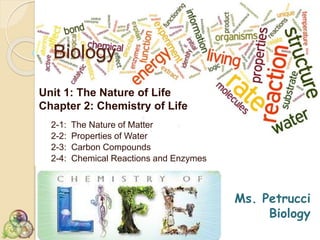
2-3: Carbon Compounds
- 1. Biology Unit 1: The Nature of Life Chapter 2: Chemistry of Life 2-1: The Nature of Matter 2-2: Properties of Water 2-3: Carbon Compounds 2-4: Chemical Reactions and Enzymes Ms. Petrucci Biology
- 2. Chapter 2: Chemistry of Life • Vocabulary • 2-1 ◦ Atom ◦ Nucleus ◦ Electron ◦ Element ◦ Isotopes ◦ Compound ◦ Ionic Bond ◦ Ions ◦ Covalent Bond ◦ Molecule ◦ Van der Waals forces • 2-2 ◦ Cohesion ◦ Adhesion ◦ Mixture ◦ Solution ◦ Solute ◦ Solvent ◦ Suspension ◦ pH Scale ◦ Acid ◦ Base ◦ Buffer • 2-3 o Monomer o Polymer o Carbohydrate o Monosaccharide o Polysaccharide o Lipid o Nucleic Acid o Nucleotide o Ribonucleic Acid (RNA) o Deoxyribonucleic Acid (DNA) o Protein o Amino acid • 2-4 o Chemical Reaction o Reactant o Product o Activation Energy o Catalyst o Enzyme o Substrate
- 3. Organic Compounds The Chemistry of Carbon • Organic chemistry is the study of all compounds that contain bonds between carbon atoms. • Compounds that contain CARBON are called organic. • Macromolecules are large organic molecules.
- 4. Carbon (C) • Carbon has 4 electrons in outer shell. • Carbon can form covalent bonds with as many as 4 other atoms (elements). • Usually with C, H, O or N. • Example: CH4(methane)
- 5. Macromolecules • Macromolecules are formed by a process known as polymerization. • Monomers – Small building blocks of polymers • Polymers – Large Organic Molecules Examples: 1. Carbohydrates 2. Lipids 3. Proteins 4. Nucleic acids (DNA and RNA)
- 6. Question: How Are Macromolecules Formed?
- 7. Dehydration Synthesis Also called “condensation reaction” Forms polymers by combining monomers by“removing water”. HO H HO H H2O HO H
- 8. Question: How are Macromolecules separated or digested?
- 9. Hydrolysis Separates monomers by “adding water” HO H H2O HO H HO H
- 10. Carbohydrates
- 11. Carbohydrates What is the function of carbohydrates? Source of Energy Structure Small sugar molecules to large sugar molecules. ◦ C, H, O Examples: monosaccharide disaccharide polysaccharide
- 12. Carbohydrates Carbohydrates are compounds made up of carbon, hydrogen, and oxygen atoms, usually in a ratio of 1 : 2 : 1. Monosaccharide: one sugar unit Examples: glucose (C6H12O6) deoxyribose ribose Fructose Galactose glucose
- 13. Carbohydrates Disaccharide: two sugar unit Examples: ◦ Sucrose (glucose+fructose) ◦ Lactose (glucose+galactose) ◦ Maltose (glucose+glucose) glucose glucose
- 14. Carbohydrates Polysaccharide: many sugar units Examples: starch (bread, potatoes) glycogen (beef muscle) cellulose (lettuce, corn) glucose glucose glucose glucose glucose glucose cellulose glucose glucose
- 15. Lipids
- 16. Lipids General term for compounds which are not soluble in water. Lipids are soluble in hydrophobic solvents. Remember: “stores the most energy” Examples: ◦ 1. Fats ◦ 2. Phospholipids ◦ 3. Oils ◦ 4. Waxes ◦ 5. Steroid hormones ◦ 6. Triglycerides
- 17. Lipids Six functions of lipids: 1. Long term energy storage 2. Protection against heat loss (insulation) 3. Protection against physical shock 4. Protection against water loss 5. Chemical messengers (hormones) 6. Major component of membranes (phospholipids)
- 18. Lipids
- 19. Lipids Triglycerides: composed of 1 glycerol and 3 fatty acids. H H-C----O H-C----O H-C----O H glycerol O C-CH2-CH2-CH2-CH2-CH2-CH2-CH2-CH2-CH2-CH3 O C-CH2-CH2-CH2-CH2-CH2-CH2-CH2-CH2-CH2-CH3 fatty acids O C-CH2-CH2-CH2-CH
- 20. Fatty Acids There are two kinds of fatty acids you may see these on food labels: 1. Saturated fatty acids: no double bonds (bad) 2. Unsaturated fatty acids: double bonds (good) O C-CH2-CH2-CH2-CH2-CH2-CH2-CH2-CH2-CH2-CH3 saturated O unsaturated C-CH2-CH2-CH2-CH
- 21. Nucleic Acids
- 22. Nucleic acids Two types: a. Deoxyribonucleic acid (DNA-double helix) b. Ribonucleic acid (RNA-single strand) Nucleic acids are polymers assembled from individual monomers known as nucleotides. ◦ linked by dehydration synthesis. CHOPN
- 23. Nucleic acids Nucleotides include: phosphate group pentose sugar (5-carbon) nitrogenous bases: adenine (A) thymine (T) DNA only uracil (U) RNA only cytosine (C) guanine (G)
- 24. Nucleotide Phosphate Group O O=P-O O N Nitrogenous base (A, G, C, or T) CH2 O C1 C4 C3 C2 5 Sugar (deoxyribose)
- 25. Nucleic acids store and transmit hereditary, or genetic, information. ribonucleic acid (RNA) deoxyribonucleic acid (DNA)
- 26. DNA - double helix P P P O O O 1 2 3 3 5 4 5 3 5 P P P O 5 2 3 O O 1 4 5 5 3 3 G C T A
- 27. Proteins
- 28. Proteins (Polypeptides) Amino acids (20 different kinds of aa) bonded together by peptide bonds (polypeptides). COHN or CHON Six functions of proteins: 1. Storage: albumin (egg white) 2. Transport: hemoglobin 3. Regulatory: hormones 4. Movement: muscles 5. Structural: membranes, hair, nails 6. Enzymes: cellular reactions
- 29. Amino acids
- 30. Proteins (Polypeptides) The instructions for arranging amino acids into many different proteins are stored in DNA. Four levels of protein structure: ◦ Primary Structure ◦ Secondary Structure ◦ Tertiary Structure ◦ Quaternary Structure
- 31. Primary Structure Amino acids bonded together by peptide bonds (straight chains) Amino Acids (aa) aa1 aa2 aa3 aa4 aa5 aa6 Peptide Bonds
- 32. Secondary Structure 3-dimensional folding arrangement of a primary structure into coils and pleats held together by hydrogen bonds. Two examples: Alpha Helix Beta Pleated Sheet Hydrogen Bonds copyright cmassengale
- 33. Tertiary Structure Secondary structures bent and folded into a more complex 3-D arrangement of linked polypeptides Bonds: H-bonds, ionic, disulfide bridges (S-S) Called a“subunit”. Alpha Helix Beta Pleated Sheet
- 34. Quaternary Structure Composed of 2 or more “subunits” Globular in shape Form in Aqueous environments Example: enzymes (hemoglobin) subunits
- 35. Some functions of proteins: ◦ Control rate of reactions – Enzymes ◦ Contractile proteins - Used to form bones and muscles ◦ Transport substances into or out of cells ◦ Help to fight disease – antibodies ◦ Hormones ◦Storage proteins – make essential substances readily available ◦Structural proteins – support and maintain shape of cell.